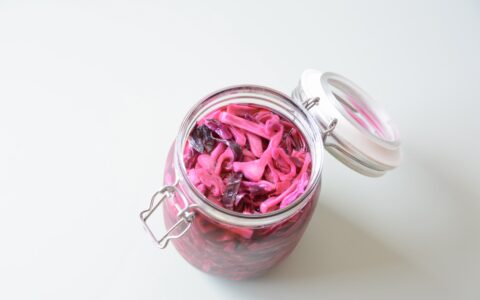Pickled red cabbage is a quick, budget-friendly, and adaptable option for those looking to explore the world of pickling. Pickled cabbage has a vibrant, fragrant, slightly sweet flavor that complements many meals. You can, for example, eat it with tacos, as parts of a salad bowl, siding burgers and finger foods, or just as it is.
In this recipe, you learn how to pickle food, with my go-to example of pickled red cabbage. You will learn how pickling differs from fermenting and what else besides red cabbage are great candidates for pickling.
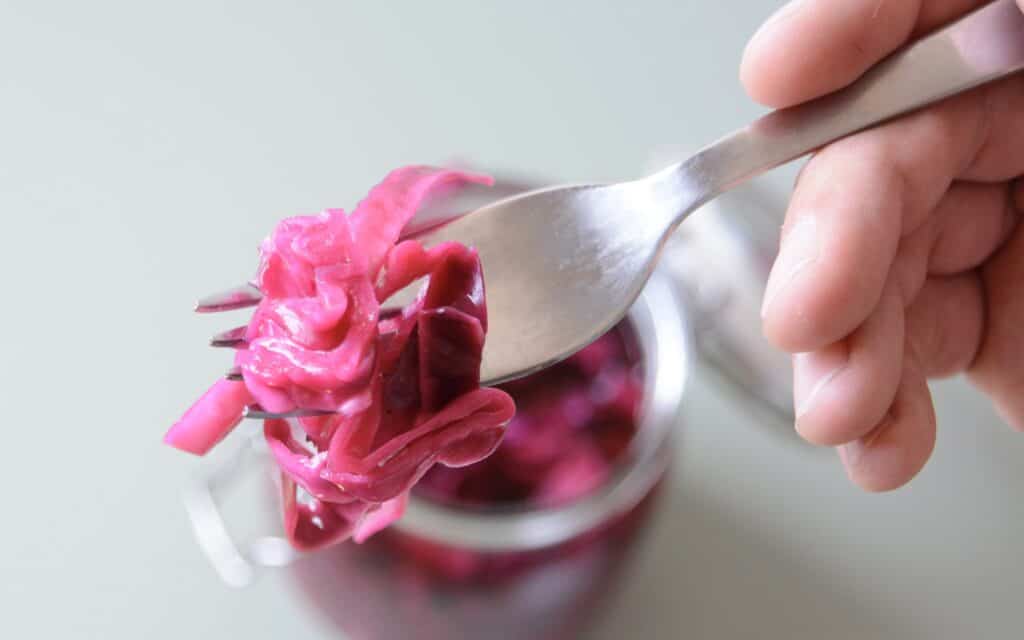
How does pickling differ from fermentation?
Both pickling and fermentation have been born as food preservation methods. While the preparation steps for pickling and fermenting are similar, their process differs drastically when storing.
When pickling, you submerge the food in a salt and vinegar solution to inhibit the growth of microbes entirely. The acidity of the vinegar is key to preventing microbe growth in pickling.
On the other hand, fermentation depends on the presence of bacteria and yeasts. You aim to create an environment where these good yeasts and bacteria can flourish while harmful microorganisms spoiling your food are locked out. These microorganisms convert sugars into organic acids like lactic acid, which brings the typical acidity of sauerkraut, kimchi, kombucha, or even yogurt.
Both approaches submerge the food to avoid contact with oxygen. If the brine is acidic enough to kill all bacteria, it's gonna be a pickling. If this sterilization does not happen, the food is going to ferment. The absence of oxygen hinders unwanted microbes to flourish in both methods.
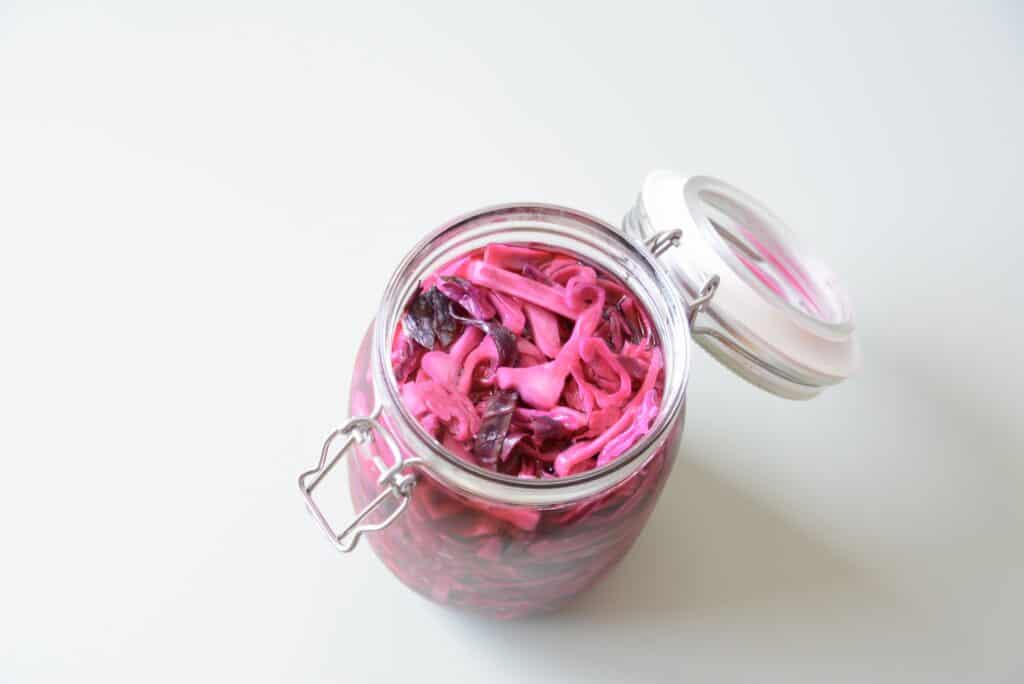
What do I need for pickling?
It doesn't require much to get started with pickling. Regarding tools, you need an airtight container and your usual chopping and cutting kitchen gear. In terms of ingredients, only the vegetable or fruit you want to pickle, plus some vinegar and water, are needed for pickling. Technically, salt and sugar are optional.
The right amount of vinegar helps preserve.
Pickling is a preservation method known for centuries. The effect of the acidity of vinegar prevents microbes from growing. Having enough acidity in your solution is key for this.
Typical household vinegar has a concentration of around 5% of vinegar acid. Following this recipe, we mix equal amounts of water and vinegar into the brine, resulting in a 2.5% concentration. This is a good recommendation to work with. To be sure the pickling works, try staying above this threshold.
If you check the concentration on your vinegar bottle and find a lower concentration than 5%, be mindful and add less water to the mix to keep the solution strong enough. On the other hand, adding more acidity won't interrupt the pickling process and should also produce good results. This will lead to a more tangent and sour taste, so it's rather a question of taste instead of outcome.
Infusing pickled red cabbage to create a unique flavor
While the base recipe is very enjoyable, consider it a canvas for your pickled cabbage experiments. It's flavorful on the palate on one side but leaves a lot of room to create countless different outcomes through the use of aromatic ingredients.
Try creating a unique flavor by infusing the pickle with various ingredients. Here's some ideas.
- Add dried Spices and Herbs: Try infusing the cabbage with dry herbs or spices. I am thinking of cloves, cinnamon sticks, star anise, ginger, bay leaf, mustard or dill. Make sure to use whole spices.
- Infusing with citrus Zest: Use a peeler and scrape a thin layer off the peel of oranges, limes, lemons, tangerine, or grapefruit and use it to infuse your pickle. Buy organic and wash properly to remove potential pesticides.
- Make it Spicy: A little touch of hotness can make this a great companion on combined dishes. Infuse the pickle with whole red peppers, Jalapeño slices, ginger, or garlic slices.
- Infuse with fresh Herbs: Basil, Thyme, rosemary,... Try adding fresh herbs!
- Enhance with Fruits: Add some apple or pear slices, cranberries, cherries or more to infuse the pickled red cabbage with a touch of fruitiness.
- Onion, garlic and Shallots: The classics from the package "oh, that smells good what you are doing" also fit perfectly well into a pickle. (Onions make a great pickle on their own, by the way!!!)
- Use various kinds of vinegar: while in this recipe, we pick relatively neutrally tasting vinegar, you can choose not to. Pick your favorite vinegar with solid character.
- any combination from above: Yes, that's right. try more than just one ingredient to change the outcome of your pickle. As long as the aromas don't compete for the attention of your nose, any combination of the above may produce a great outcome.
How long should I pickle the cabbage until it is ready?
Pickling is a traditional way to preserve food. A batch is intended to be kept for quite some time, and you can eat from it little by little. Preparing the pickle in advance may be wise to reach the desired softness. But it's not necessary to fully pickle the ingredient before using it. Even a half-done pickle has its charm.
While submerged in vinegar, the texture of cabbage will change slowly over time. You can expect a tender texture after two days. From here, pickled cabbage will continue to mature in flavor over time.
However, this does not mean that the result is not good if you consume it earlier. A shorter pickling time leads to a less effective pickling.
- Within the first 20 minutes, not much happens. You might see how the brine gets some purple tint, but that's it. Eaten like this, you will have a crunchy cabbage with a decent punch of acidity.
- After 12 hours, the color fully developed, and the cabbage's texture softened quite a bit. The first aromas show up.
- After two days, changes in texture are done. This is peak time for a fresh pickle, combining a tender texture with vibrant acidity and aroma.
- From here, the pickle will mature over time. The aromatic complexity will change slightly, but the overall result stays.
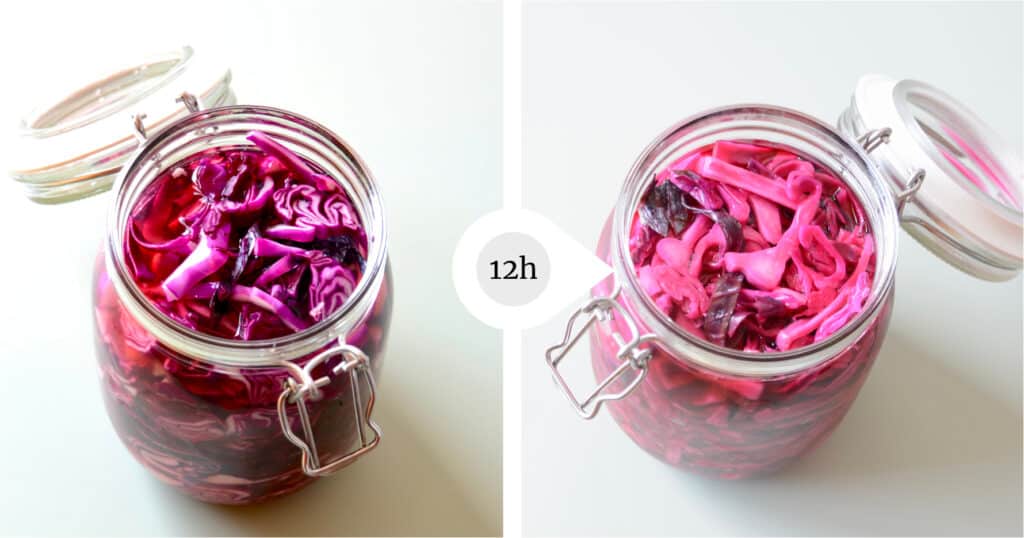
How long can I store my pickled cabbage?
Given that you work cleanly during preparation, you can store your pickled red cabbage for months in the fridge in an airtight container. On its own, the pickle won't go bad quickly. Microorganisms like bacteria or molds, however, can easily spoil your cabbage. You should work with clean hands and sterile tools to ensure long-lasting freshness. Consider the following tips to ensure a long shelf life
- Keep your tools clean: Sterilise your knife, cutting board and airtight container. A clean workspace is the foundation to avoid food spoilage.
- Store properly: Put the airtight container in your fridge to shield it from heat, light and oxygen. These are necessary for bacteria to grow, so don't give this opportunity to spoilage.
- Keep the cabbage submerged in its brine: Mold develops where it can breathe. If you keep the food submerged in its brine, this can't happen. Tap up the container with more vinegar-water mix if parts of the pickle are in contact with air.

Pickled Red cabbage
Ingredients
- 500 g red cabbage
- 240 ml water
- 240 ml vinegar wine or apple
- 1 tbsp sugar
- 1 tsp salt
Instructions
- Slice the red cabbage finely. Squeeze the slices into a big jar with lid, fill up until the top.
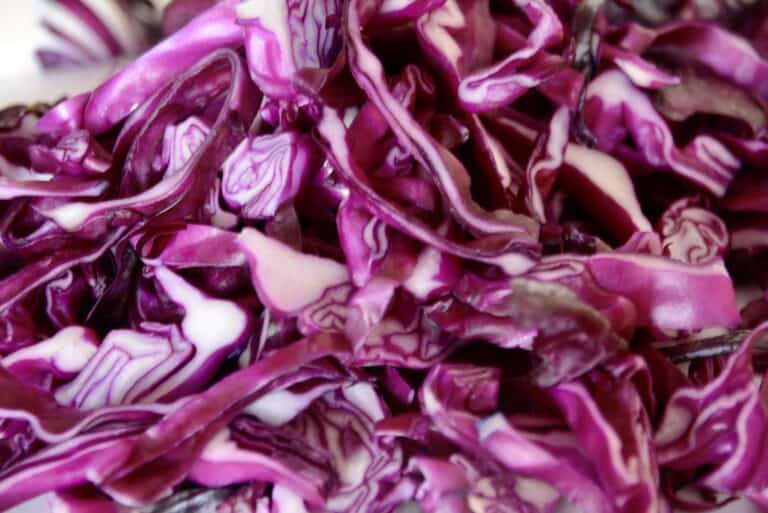
- Mix vinegar and water in a rough 50:50 ratio. Add a tablespoon of sugar and a teaspoon of salt to the jar. Close the jar and shake it properly to distribute the sugar and salt evenly

- If you want to infuse your pickled cabbage with spices, herbs, or other ingredients, add them at this step.
- Move the jar into your fridge and let the cabbage pickle overnight. Next day, your cabbage is ready to eat!
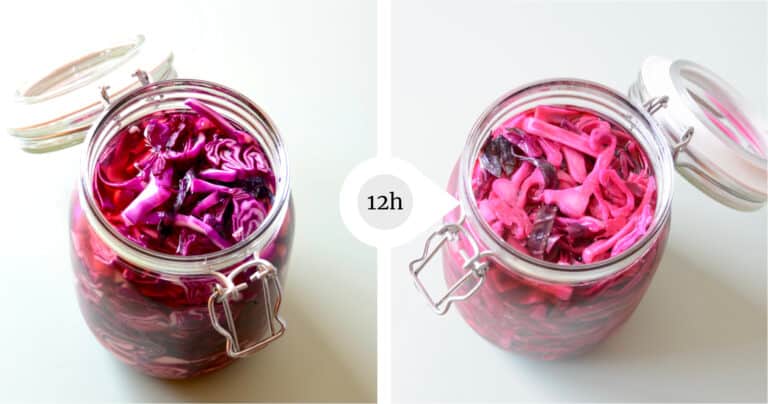

Love this recipe? You’ll love my book too!
Learn to cook healthy and flavorful meals from scratch and boost your well-being through nutrition.
Get your copy of “Embracing Change” now.
Nutrients per serving

